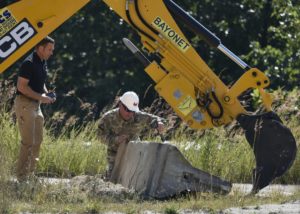By Brian Hill
FORT LEONARD WOOD, Mo. (Sept. 24, 2021) — Army Forces Command Soldiers from installations in Colorado, Kansas and Texas, assessed the military utility of emerging technologies here over the past two weeks as part of the annual Maneuver Support, Sustainment and Protection Integration Experiments.
Commonly referred to as MSSPIX, the event provides military sponsors with an opportunity to put the latest tools in the hands of Soldiers while also giving capability developers and the science and technology community credible and validated operational experiment venues for their conceptual and materiel development, said Kyle Henry, the Maneuver Support Battle Lab’s Experimentation Branch chief and one of the key organizers.
“Without the Soldiers, this would be a glorified tech demo,” he added. “That’s not what we’re trying to do. We want a non-biased look at these technologies, these capabilities.”
This year, the focus was on the All Domain Protection Functional Concept, Henry said, and the technologies being assessed are designed to minimize a Soldier’s presence on the battlefield, or otherwise aid in protecting lives. Many of the developer’s descriptions included words such as “autonomous,” “unmanned” and “robotic.”
One of the capabilities assessed this year was the Route Clearance and Interrogation System, or RCIS, which is a retrofitted system for Army Engineer vehicles that provides remote control functionality and a video interface via multiple camera mountings.
Staff Sgt. Rashad Hailey is a horizontal construction engineer from the 41st Clearance Company at Fort Riley, Kansas, who has been working with heavy equipment for nine years. However, he never operated an excavator remotely until he participated in the RCIS assessment at Training Area 401.
After a few hours with the system, Hailey said he felt comfortable operating the equipment without actually sitting in the cab. He assessed his ability to accurately dig from both line of sight and from inside another vehicle, using the video feed.
“I’m not a gamer, so it was kind of interesting trying to operate the excavator while watching a screen,” he said. “But I was able to do just as well either way.”
Another new technology looked at this year is called the Bayonet Breaker, which is an attachment that can be installed on existing equipment that allows one vehicle to have multiple uses. For the assessment, Army Engineers attempted to use the bucket of an excavator, and then quickly switch to a fold-down hammer that can break up rock or cement without having to leave the cab of the vehicle.
Chief Warrant Officer 5 Frank Davis, senior warrant officer advisor for the National Guard to the U.S. Army Engineer School, sponsored the assessment — Soldiers from Fort Carson, Colorado, and Fort Hood, Texas, provided feedback.
“This was a technology we were interested in seeing more of,” Davis said. “There’s a lot of interest in the capability because we have a lot of dig assets in the Army, and there’s a need to be able to continue to dig when we hit solid objects, so we don’t have to reroute where we’re digging or change what we’re doing because something got in our way.”
Other technologies assessed this year included a drone-based route reconnaissance analysis tool, a lightweight chemical detection pouch system and an autonomous signal direction finder.
Some technologies are making a return after receiving feedback during a previous MSSPIX. The Electromagnetic Induction Sensing for Subterranean Infrastructure Assessment, or EMI, was first debuted at MSSPIX in 2019, for example. The system — designed to be a portable way for Army Engineers and Military Police to look for underground infrastructure that can be used by adversaries in an urban environment — has been upgraded based on feedback received from Soldiers and analysts.
“There were six or seven points where they said we could improve upon it,” said Josh McCleave, a research civil engineer at the Army’s Engineer Research and Development Center in Vicksburg, Mississippi, and the system’s project manager. “So, after a year and a half, we’re back for MSSPIX ’21 to show the improvements we’ve made based on those recommendations.”
McCleave said the reason MSSPIX is “hugely beneficial” for the science and technology community is the Soldier feedback.
“If we can get that feedback early and often during development, it really helps accelerate the final product to be what the Army really needs,” he said.
Henry added that Soldier-provided feedback and other collected data from the assessments helps shape capabilities and their development — all to the benefit of Army modernization efforts.
“This (EMI) is a success story and it’s a good example of what we’re doing here,” he said. “It’s mutually beneficial for the developers and the Army. We get to look at prototype-level technologies in an operationally relevant environment in the hands of Soldiers, and on the technology provider side, they get direct feedback from Soldiers.”






-30-
About Fort Leonard Wood
Fort Leonard Wood is a thriving and prosperous installation that has evolved from a small basic training post 80 years ago to a premier Army Center of Excellence that trains more than 80,000 military and civilians each year.
Fort Leonard Wood is home to the U.S Army Maneuver Support Center of Excellence and three U.S. Army schools: the U.S. Army Engineer School; U.S. Army Chemical, Biological, Radiological and Nuclear School; and the U.S. Army Military Police School. In addition to training engineer, CBRN and military police specialties for the Army, Fort Leonard Wood also provides gender-integrated in-processing and Basic Combat Training for new Soldiers.
Fort Leonard Wood also hosts and trains with the largest Marine Corps Detachment and Air Force Squadron on any Army installation as well as a large Navy construction detachment.
More information about Fort Leonard Wood is at: https://home.army.mil/wood/index.php/about/mission
